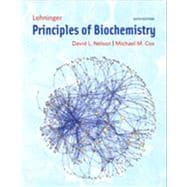Clear writing and illustrations…Clear explanations of difficult concepts…Clear communication of the ways in biochemistry is currently understood and practiced. For over 35 years, in edition after bestselling edition, Principles of Biochemistry has put those defining principles into practice, guiding students through a coherent introduction to the essentials of biochemistry without overwhelming them.
The new edition brings this remarkable text into a new era. Like its predecessors, Lehninger Principles of Biochemistry, Sixth Edition strikes a careful balance of current science and enduring concepts, incorporating a tremendous amount of new findings, but only those that help illustrate biochemistry’s foundational principles. With this edition, students will encounter new information emerging from high throughput DNA sequencing, x-ray crystallography, and the manipulation of genes and gene expression, and other techniques. In addition, students will see how contemporary biochemistry has shifted away from exploring metabolic pathways in isolation to focusing on interactions among pathways. They will also get an updated understanding of the relevance of biochemistry to the study of human disease (especially diabetes) as well as the important role of evolutionary theory in biochemical research.
These extensive content changes, as well as new art and powerful new learning technologies make this edition of Lehninger Principles of Biochemistry the most impressive yet.
See what's in the LaunchPad








